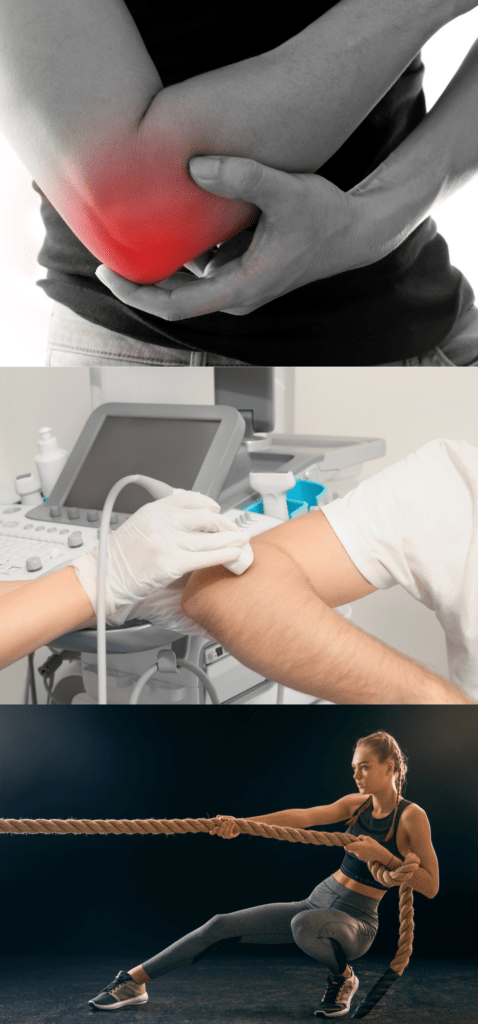Tennis elbow is a nasty ailment affecting more than just tennis enthusiasts, can be a persistent challenge. At Achieve Health we recognize the impact of this condition on daily life. In this article, we delve deeper into our multifaceted approach, incorporating a range of modalities, including needling, deep soft tissue massage, and detailed exercises, to ensure a holistic and effective recovery.
Understanding Tennis Elbow:
Tennis elbow, or lateral epicondylitis, arises from the overuse of forearm and arm muscles (see the below case study for an example of why this happens in the first place), leading to pain and inflammation around the outer part of the elbow. Our goal is to provide a comprehensive treatment strategy that addresses the root cause and promotes long-lasting relief.
Our Comprehensive Treatment Approach:
1. Manual/Hands on Treatment
Our skilled therapists employ a range of manual therapy techniques to reduce pain, enhance healing, address muscular imbalances and restore normal joint function.
Deep Soft Tissue Massage: Therapeutic massage techniques target specific muscle groups associated with tennis elbow. This not only alleviates pain but also promotes blood circulation, facilitating the removal of metabolic waste and accelerating the healing process.
Joint Mobilizations: Gentle joint mobilizations help improve the range of motion in the affected joint, reducing stiffness and enhancing overall functionality.
Needling: In cases where persistent trigger points contribute to discomfort, dry needling may be recommended. This aids in pain reduction and improves muscle function.
2. Exercises:
Our physical therapy sessions are tailored to individual needs. We start with a thorough assessment to identify specific weaknesses and imbalances. Exercises focus not only on the affected area but also on surrounding muscles, aiming to correct any contributing factors.
Strengthening Exercises: Targeted exercises include eccentric strengthening of the wrist extensors, emphasizing controlled lengthening of the muscles. This promotes improved muscle endurance and resilience.
Stretching and Mobility Training: We incorporate stretching routines to enhance flexibility in the forearm and wrist, alleviating tension and reducing strain on the affected tendons.
3. Shockwave Therapy:
For cases requiring a more intensive intervention, perhaps one that’s been long-standing, we can introduce shockwave therapy.
Focused Shockwave Treatment: This non-invasive technique delivers high-energy shockwaves to the affected area, triggering a regenerative response. It accelerates healing, reduces pain, and enhances tissue repair.
4. Injections
In some rare and more extreme cases injections can be offered to provide more immediate pain relief/anti-inflammatory properties. Injections can complement other treatment modalities, such as physiotherapy and exercise programs. By reducing pain and inflammation, injections create a more conducive environment for individuals to engage in rehabilitative activities.
Case Study: Sarah’s Triumph Over Tennis Elbow
Sarah, a 35-year-old Cross-fitter, faced persistent tennis elbow. She had suffered with it on and off for 18 months and had already tried some physio elsewhere, exercises and stretches herself.
Upon discussion within the initial appointment, it was clear she hadn’t ever addressed the cause or promoted the damaged tendons to truly heal.
We assessed in the initial appointment that Sarah had 2 big contributing factors to the recurring injury, that likely linked to the lack of improvement:
- Poor Scapula Control
The scapula, or shoulder blade, plays a pivotal role in the coordination and stability of the shoulder complex. Inadequate control of the scapula can lead to a cascade of biomechanical imbalances, affecting the entire upper limb.
- A previous wrist sprain – leaving a restricted wrist joint.
The reduced range of motion at the wrist could have caused increased tension on the lateral epicondyle, overcompensation of the forearm muscles and altered her biomechanics during Activities – especially highlighted because of her chosen sport – Crossfit (Lots of gripping!)
So not only did we focus on pain relief and healing the injury, we ensured to address the contributing factors – so this time the pain wouldn’t come back!

Her personalized treatment plan included:
Hands on Treatment:
- Deep soft tissue massage, dry needling and cupping focusing on the affected tendon and forearm muscles.
- Joint mobilizations to improve range of motion – at the elbow and the wrist.
Exercises:
- Eccentric strengthening exercises targeting the wrist extensors.
- Scapula Retraction work such as Is, Ys, and Ts
- Gradual increase in load for the wrist, elbow and shoulder structures over 6 weeks.
Shockwave Therapy:
- X4 sessions of focused shockwave treatment for accelerated recovery.
Sarah experienced a remarkable reduction in pain and regained full functionality over the six-week intervention. Not only was the injury itself addressed, but Sarah is now working on the problem areas that added to the injury in the first place: she finished up even stronger than before!
Conclusion:
Our comprehensive approach to treating tennis elbow extends beyond conventional methods, embracing cutting-edge techniques shockwave therapy. Whether you’re a sports enthusiast or someone dealing with occupational strain, our expert team at Achieve Health is here to guide you toward a pain-free and resilient future. Don’t let tennis elbow disrupt your life – let us be your partner in reclaiming control.
